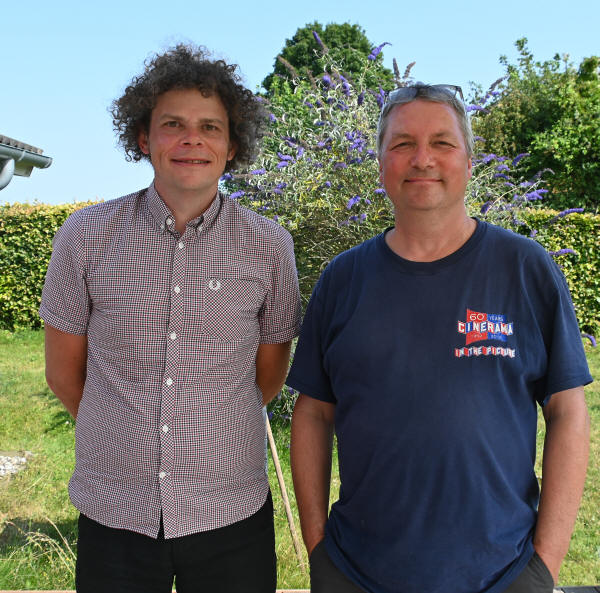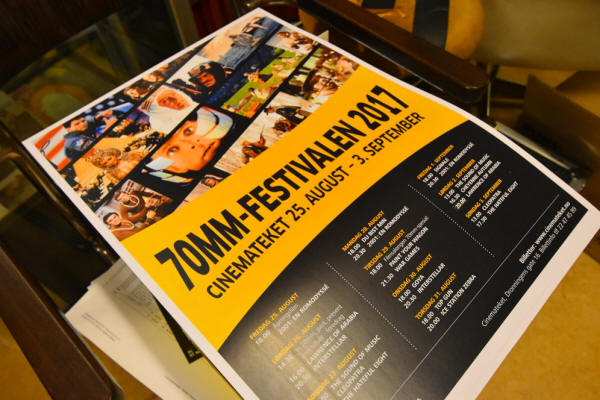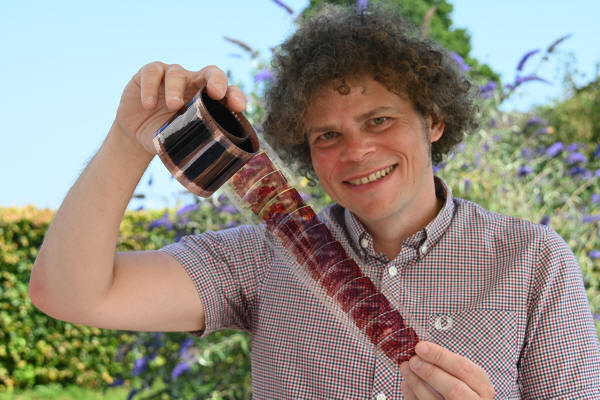A Conversation with Jan Olsen about Oslo 7OMM Festival |
Read more at in70mm.com The 70mm Newsletter |
| Conversation hosted by: Thomas Hauerslev. Transcribed by: Mette Petersen | Date: 20.06.2022 |
 Jan
Olsen (left) and Thomas Hauerslev (in70mm.com editor) met in July 2021, for
a chat about the Oslo 7OMM Festival. Picture by Charlotte Hauerslev Jan
Olsen (left) and Thomas Hauerslev (in70mm.com editor) met in July 2021, for
a chat about the Oslo 7OMM Festival. Picture by Charlotte HauerslevJan Eberholst Olsen (born 1974), is the Technical Chief of Projection at the Norwegian Film Institute in Oslo (Norway), where he has been employed for 25 years now. Since August 2000, Jan has curated the Oslo 70mm Festival, which has evolved into a respected 70mm film festival with an international audience. Unofficially, Jan is also the enthusiastic collector of more than 50 tons of old projection equipment, and runs a remote cinema museum deep in the Norwegian mountains with his long-time friend Torkel Sætervadet. Jan and his wife also run a second-hand shop with vintage furniture and interior decor in central Oslo. Jan is half Danish and half Norwegian and often spends his holidays in Denmark with his wife Lise and daughter Wilma. During a visit in the summer of 2021 we met for a conversation about 70mm and the festival. Thomas Hauerslev: Tell me about the Oslo 70mm Festival Jan Olsen: Oslo 70mm Festival was strongly inspired by the Widescreen Weekend in the '90s in the UK. I travelled there every year from the late '90s. 1997 was my first year. I thought that the attention given to 70mm from our own archive, and in our own programming, at my work at the Norwegian Film Institute was not sufficient. There were just a few titles they found interesting. They found "Play Time" interesting and "West Side Story" and "2OO1". The rest they thought were a bit too commercial for everyday or regular booking. Maybe "Spartacus" could be interesting, because it was Stanley Kubrick. The rest of the titles we held were thought to be too popular. At that time, films like "The Sound of Music" and similar movies were never programmed at the Cinemateket. They were very strict, as I think is in most Cinemateks around the world. It is a common idea, that you have certain canons of films or filmmakers, which are sort of repeated all the time. Commercial movies, including blockbusters, comedies or musicals, regardless of the decade, are not the purpose of a Cinematek. Maybe in other countries where you have more non-commercial cinemas which can serve that part of the market, but in Norway at that time it was either municipal cinemas with the contemporary movies, and the Cinematek for classic movies. Middle age movies, like the blockbusters of the 70mm films, were not regarded as "the thing to screen". Since opening, upon the insistence by our Technical chief at that point, Torkel Sætervadet, and myself, we have had the capability of screening 70mm at the Cinemateket. The goal when we opened the Film Institute was supposed to be Victoria 8 projectors in the main auditorium and Swedish AGA-Baltic projectors in the small auditorium. At the end we managed to convince the Film Institute to install DP70s in the main auditorium and to move the Victoria 8s to the small auditorium. Of course we wanted to nurture our interest and passion for the 70mm format from the beginning. We were hugely inspired by the Cinerama installation [in Bradford], along with the idea of actually watching movies for an entire weekend, on the louvered screen or a big screen, together with other enthusiasts with the same passion. For me it was for quite apparent this would initially be a local festival, hopefully also attracting people from abroad. The idea of the festival came from me as Technical Manager at that point, and not from the Program Committee. The first year I only put on films which I wanted to see myself. Rare films, and looking back at some of those [titles] that year, it was very hard to program 70mm during weekdays, because they are all 2½ - 4 hours long, and they have an intermission. It is difficult to find room for two films on week days, so we screened one film every day for a week. We worked quite hard on it and we screened a good number of films that year. It was very successful, and because it was successful, we were able to repeat the festival. THa: How did you convince the Cinematek management to do that, if they were kind of reluctant in the first place? Jan: The Head of the Cinematek, Kjell Billing didn't like 70mm because the prints had faded. We were already screening a lot of good [35mm] art films, which were also faded, but that didn’t seem to matter that much. The head of the section above the Cinematek, however, was an eager fan of 70mm, because she grew up with the films in the '60s, and she saw a lot of those movies when they were new. She was very supportive. I remember she sponsored a kind of opening reception the first year. I think that affected the Cinematek [attitude] at that point. They [Program Committee] still thought it was a bit odd, however.
But when it worked and people came - and
it was a different kind of audience maybe - our regular audience, but also a few
new members, it was proven that it worked quite well. We
worked quite a lot to make it work, and helped out with the marketing. We tried
to promote it as
others did, marketing it as "Wide Screen". |
More in 70mm reading: Oslo 7OMM Festival "ID4" World Premiere of 70mm DTS at the Spektrum, Oslo, Norway On the Trail of "Windjammer" - A Visit to Oslo Widescreen Weekend, Bradford, England 70mm Retro - Festivals and Screenings |
 2017
Festival poster. Picture by Thomas Hauerslev 2017
Festival poster. Picture by Thomas HauerslevTHa: How often do you have the Oslo 70mm Festival? Jan: We ran every year, 2000 - 2005. It takes a lot of time and work to make it go the way I want it to work. 2005 was a year were the attendance was quite low for "Lawrence of Arabia", which we screen every year. I was actually a bit upset that we didn’t manage to fill the auditorium. This was possibly the last chance to see it, but maybe the audience was saying "Ohh, but I can see it next year". I felt that the audience took it for granted. So in 2006 we said, "... no we are waiting. The next one will be in 2007". In 2006 people were very upset that we didn’t have a 70mm festival. Then we tried to look away from Hollywood. The first 5 years had been largely Hollywood content. Then we tried to broaden and started doing some German [DEFA 70] movies and some Russians movies [Sovscope 70]. We expanded the "70mm repertoire of the world". After seeing all the movies, it was interesting to try finding something new. And then around that time new 70mm prints [began to] arrive! In the beginning when we started, I thought that [vintage faded 70mm prints] were the only way. I never thought that I would ever see a [classic] 70mm film with proper color. [For our festival] they had all been original prints, and it seemed very, very remote that any Hollywood studio would strike new [70mm] prints from their library. It seemed sort of impossible, but then it began with 20th Century Fox in 2002/03, and it was kind of a game-changer for the festival. For me it was always a good mix for the screen to get some of those really unique and restored movies in addition to the vintage ones. And some odd ones. Maybe some blow-up films from the '80's as well. It is kind of difficult for the audience to tell the difference [of a blow-up]. A few of them would probably be able to see or actually explain why this film is sharper or better, or something. I think most of them are happy, when they are told that this is really good. Their expectations are supposed to be really high when you put on a good show. I think that they all will be happy. It is almost like when you go to a fancy restaurant enjoying a really nice wine. You should really know your stuff if you are actually saying "This bottle of wine for a 1000 kr, or 100 Euro, is really bad". It's about putting on a show. A performance. We are very eager to tell that that it's not "just" a film, but that it is more of an experience, which you have to see in a theatre, with intermission and selling chocolate and candy. We are trying to do it as close to the original experience as possible. That is sort of our main goal. THa: Can you describe the cinema you are showing your films? Jan: Our main auditorium, the Tancred cinema is, I would say, unfortunately in a modern building built in 1996. Seating is stadium and we have been doing quite a lot of incremental improvement since the time we opened the cinema in 1996, and the following 15 years. Screen size is 10,5 x 4,5 meters. We use the same lenses [focal length] as used at the Colosseum [screen 1], Oslo's big traditional and former Todd-AO cinema. Those are 87mm projection lenses, by Isco. The screen is not that big, but compared to the seating, it is quite OK. We have a very OK screen, and an extremely good Dolby Atmos / Meyer [speakers] sound system. The tuning, which is very crucial in every auditorium, is on a very high level, because we use the cinema as a reference cinema for the Norwegian film industry. We are able to reproduce the film's sound to the filmmaker's intent. That is very important. Not adding anything and not subtracting anything. That is also important to me. All films benefit from that. If we are screening even a digital "This is Cinerama" or "Windjammer", you still provide, with our Dolby Atmos system, just mono surround which will work well, or we can operate with a split surround, which will work really well, because [the auditorium] is calibrated and made for the modern blockbusters to be a reference cinema. THa: How many seats do you have? Jan: It is approx. 200 seats, 10 rows and the screen is 10,5 meters, by 4,5 meters. THa: If you sit close enough you are really "in the movies"? Jan: Yes, some people are happy really up front. Some people have their favorite seats, sort of in the middle, row 5 maybe, depending on the movie. If it is 70mm you can sit a bit closer, if it is 35mm maybe a row back, if it is digital maybe on row number 8. |
|
 Jan
Olsen in July 2021 with a piece of historic Todd-AO film. Picture by Thomas
Hauerslev Jan
Olsen in July 2021 with a piece of historic Todd-AO film. Picture by Thomas
HauerslevTHa: What does 70mm mean to you? Jan: To me it means, shows which use the format best, I think of some of the restored prints, like "Lord Jim", "Lawrence of Arabia" and "Spartacus". When you have the 5 front channels, directional dialog, I think it is a very great part of it. Also with vintage prints like "My Fair Lady", the restored "The Sound of Music", you also have the travelling dialog. I think that gives a unique experience for me. It is the combination of enjoying the movies, but also that technology. It's not that easy. It is not for everyone. This is sort of ... I am not sure if it is an acquired taste, but I know all the efforts that go into it, and it is razor sharp. Every time we screen 70mm, I am surprised how sharp it is. It is really nice. We try to optimize it during rehearsals, and then it is even sharper. You get accustomed to seeing either low resolution, or our everyday projection of new movies, which is now mostly digital. It looks very different. I am not saying that new stuff looks bad, but it looks so different in my eyes, and I even appreciate it [the difference] more now, when I know it is so rare to see a 70mm print projected, because it is more difficult to get the prints from anywhere. So I appreciate it more now than I did 20 years ago. THa: Any favorite 70mm films? Jan: I think that number 1 must be "Lawrence of Arabia". I have seen it dozens of times, but it seems to give me a different reaction every time I see it. It has meant different things for me in different stages of my life, kind of, so it may be pretentious to say, but it gives me something new. I recently saw "Spartacus" again. That was my first film ever in 70mm. It was the first old film I saw in a movie theatre – ever – in February 1990. We screened it in 2001 at the 70mm festival, and we screened it again in 2019. I really, really enjoyed it. More than I did the two previous times. It was difficult to get the print, so I think it is a mix of sometimes getting something rare. I really like "Play Time", which is in 1,75:1 aspect ration wide screen. It doesn’t matter for me. It can be simply admiring how sharp it is. There is a mix of different feelings. It is sort of a combination of a really, really nice print, the sharpness, sitting alone to see it, and seeing it with an audience. It's more like some favourite movie experiences, like when we did "War and Peace" the first time. We were not even sure the print would be able to be screened without interruption because it was rather strongly shrunken. Then we sold out for an eight hour show! People were really eager to see it. But [for me] it has to be those big American blockbusters I think. "Khartoum" I also really like. Of the blow-ups I like "Where Eagles Dare". The momentum in the beginning is one of my favorites. It is difficult to choose. "West Side Story" I think, must be up there among the three best movies ever too. My mother had the soundtrack and she played it all the time, so I it reverberates fine with me as well, but I think that it is also a really good movie. Not always as sharp as some, but it is a good movie. And I also had the same reaction when we screened "South Pacific" for the first time. I like "South Pacific" as well. I never thought that we would be able to screen it. It seemed impossible to see that with the original color, or see it at all. But there we were screening it along with "The Miracle of Todd-AO", recreating that original experience like they did in 1958. That was something special THa: When can we expect the next Oslo 70mm Festival to take place? Jan: We were hoping to do one in 2021, but due to Covid regulations we were not willing to do a half full festival with restrictions. It has to be open. It has to be like normal times. People must be able to travel. We have had had some "exotic" guests, all the way from Seattle in the US, Tokyo in Japan, several new visitors from the UK, and people wanting to see some of the films we screened maybe 5-10 years ago. And new local audience. I think that we gathered quite a number new audience members in the aftermath of our successful screening of "The Hateful Eight" especially, but also "Dunkirk". The sort of New Wave of 70mm films spurred some interest in the classic movies. So, Corona needs to be decreased, and we also must have something new to offer. I think that could be in 2022, but when in 2022 we don’t know. You will be the first one to know. |
|
| Go: back - top - back issues - news index Updated 22-01-25 |
